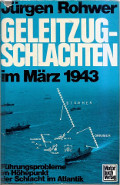HX-229
Homeward from Halifax (North Atlantic)16 Mar 1943 - 19 Mar 1943
| The Convoy | 37 ships |
| First sighting | On 16 Mar 1943 by U-336 |
| Escorts | Convoy escorted by B-4 Group CDR ECL Day RN (but commanded by LCDR GJ Luther RN until CDR Day arrived in HMS Highlander) V&W class destroyer HMS Volunteer Town class destroyers HMS Beverly, HMS Mansfield Flower class corvettes HMS Anemone, HMS Pennywort Havant class destroyer HMS Highlander joined 3/18 Flush deck destroyer USS Babbitt joined 3/19 Flower class corvette HMS Abelia joined 3/19 |
U-boats | Gruppe Raubgraf U-84 KL Horst Uphoff U-89 KL Dietrich Lohmann U-91* KL Heinz Walkerling U-435* KL Siegfried Strelow U-600* KL Bernhard Zurmuhlen U-603* OL Hans-Joachim Bertelsmann U-615 KL Ralph Kapitsky U-653 KL Gerhard Feiler U-664 OL Adoph Graef U-758* KL Helmut Manseck (Gruppe Dranger) U-86 KL Walter Schug U-221* OL Hans Trojer U-333* OL Werner Schwaff U-336 KL Hans Hunger U-373 KL Paul-Karl Loeser U-406 KL Horst Dietrichs U-440 KL Hans Geissler U-441* KL Klaus Hartmann U-590 KL Heinrich Muller-Edzards U-608* KL Rolf Struckmeier U-610 KL Freiherr Walter von Freyberg-Eisenberg-Allmendingen (Gruppe Sturmer) U-134 OL Hans-Gunther Brosin U-190 KL Max Wintermeyer U-229 OL Robert Schetelig U-305* KL Rudolf Bahr U-338* KL Manfred Kinzel U-384* OL Hans-Achin von Rosenberg-Gruszczynski U-439 OL Helmut von Tippelskirch U-523* KL Werner Pietzch U-526 KL Hans Moglich U-527* KL Herbert Uhlig U-530 KL Kurt Lange U-598 KL Gottfried Holtorf U-618 KL Kurt Baberg U-631* OL Jurgen Kruger U-641 KL Horst Randtel U-642 KL Herbert Brunning U-665* OL Hans-Jurgen Haupt U-666* OL Herbert Engel (not assigned to patrol groups) U-228* OL Erwin Christopherson U-230 KL Paul Siegmann U-616* OL Siegfried Koitschka U-663* KL Heinrich Schmid * U-boats that fired torpedo or used the deck gun |
The battle | During the winter of 1942-43, the central part of the North Atlantic convoy route from Canada to England was known as the "air gap," because it was beyond the range of most shore based patrol aircraft. U-boats were stationed at thirty kilometer intervals in long north-south lines perpendicular to the convoy routes. Any convoy crossing one of these gruppe lines would theoretically be sighted by at least one U-boat which would report and follow the convoy to direct others until there were enough U-boats present to launch a wolf pack attack. In mid-March Gruppe Raubgraf ("robber baron") was stationed on the western edge of the air gap, and Gruppes Stürmer ("daredevil") and Dränger ("harrier") formed a long line through the air gap center. Slow convoy SC-122 passed eastbound through Gruppe Raubgraf's area a day before that line was formed; and eastbound fast convoy HX-229, behind SC-122 on the same course, slipped through the line during a storm. U-653 had a conning tower watch crew swept overboard during a storm. Low on fuel, and with a single defective torpedo remaining, U-653 was detached from Gruppe Raubgraf to return to France. Homeward bound U-653 overtook HX-229 at 0330 16 March. Sighting an eastbound convoy at dawn near the western edge of the air gap offered excellent prospects of gathering a large wolf pack for an attack on the evening of 16 March, and the remainder of Gruppe Raubgraf was ordered to catch the convoy. Gruppes Stürmer and Dränger were then ordered to converge on HX-229 from ahead of the convoy. Seven U-boats from Gruppe Raubgraf and 2 refueled by nearby U-119 and U-463 found HX-229 during daylight hours and attacked during darkness. Eight ships were torpedoed before morning. Meanwhile U-338 from Gruppe Stürmer found SC-122 shortly after midnight 120 miles ahead of HX-229. U-338's first salvo torpedoed four ships from SC-122. Admiral Donitz ordered some U- boats from Gruppes Stürmer and Dränger toward SC-122 rather than HX-229 as soon as he realized two convoys were involved, but German records refer to the two nearby convoys as a single battle -- Geleitzug Nummer 19. Very long range (VLR) Liberator patrol bombers from RAF 86 squadron at Aldergrove, Northern Ireland, and 120 squadron at Reykjavik, Iceland, made some of the first effective patrols into the air gap on 17 March and shadowing U-boats were surprised near both convoys. U-boats torpedoed 2 more ships from HX-229 and 3 from SC-122 despite interference from the Liberators. Liberators again reached SC-122 on 18 March, but were unable to find HX-229 only 70 miles away. U-boats torpedoed 2 more ships from HX-229 and another from SC-122. A freighter from HX- 229, Matthew Luckenbach, became alarmed at the continuing loss of ships and "romped" (left the convoy without authorization to proceed directly to England at its best speed.) Another freighter, the Clarissa Radcliffe, which had straggled from SC- 122 during a storm on 9 March, was never seen again and is believed to have steamed independently until torpedoed by U-663 on 18 March. Additional escorts and increasing numbers of patrol bombers reached the convoys on 19 March. U-384 was sunk by a bomber, and U-boats were ordered to discontinue attacks that night. The Matthew Luckenbach was the only ship torpedoed on 19 March as its flight from HX-229 took it into the concentration of U-boats around SC-122. SC-122's escorts saw the plume from the torpedo explosion and rescued the freighter crew. |
Article compiled by Tom Linclau
Ships hit from convoy HX-229
77 convoys on route HX were hit by U-boats in the war. Read more about them.
Media links
|
|
|
Return to convoy information - convoy battles page.
As an Amazon Associate uboat.net earns a commission from qualifying purchases.




